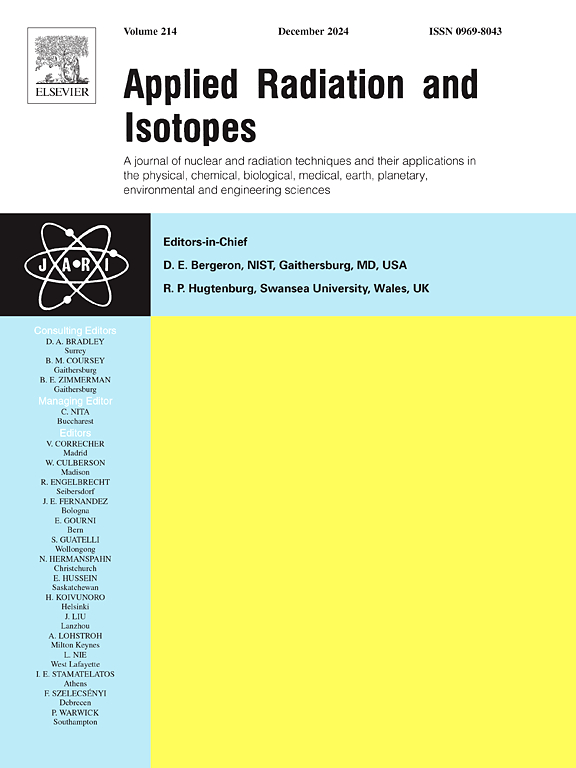表面活性剂改性mg/al层状双氢氧化物对152+154Eu(III)的高效吸附
IF 1.8
3区 工程技术
Q3 CHEMISTRY, INORGANIC & NUCLEAR
引用次数: 0
摘要
放射性废液的修复,特别是那些含有络合配体的废液的修复,仍然是一个严峻的环境挑战。本研究采用十六烷基三甲基溴化铵(CTAB)一锅法对镁铝层状双氢氧化物(Mg/Al-LDHs)进行了改性,以提高其对典型放射性核素污染物Eu-EDTA阴离子配合物的吸附性能。采用FT-IR、XRD、SEM、TGA/DTA等手段对改性LDH材料进行了结构、形貌和热性能表征。吸附实验表明,在60 min内,90%的Eu-EDTA被去除,180 min后达到平衡。改性后的吸附量增加了50%,对152+154Eu的吸附量最大达到36.6 mg g−1。动力学数据与拟二阶模型拟合较好,而Langmuir等温线最能描述平衡行为。热力学参数证实了吸附过程的吸热和自发性质。这些发现表明,ctab修饰的LDH是一种很有前途的材料,可以有效地去除水溶液中的阴离子放射性核素配合物。本文章由计算机程序翻译,如有差异,请以英文原文为准。

Efficient adsorption of 152+154Eu(III) by surfactant modified mg/al layered double hydroxide
The remediation of radioactive liquid waste, particularly those containing complexing ligands, remains a critical environmental challenge. In this study, magnesium–aluminum layered double hydroxides (Mg/Al-LDHs) were modified via a one-pot synthesis using cetyltrimethylammonium bromide (CTAB) to enhance their adsorption performance toward Eu-EDTA anionic complexes, a model radionuclide contaminant. The modified LDH materials were characterized by FT-IR, XRD, SEM, and TGA/DTA to assess their structural, morphological, and thermal properties. Adsorption experiments revealed that 90 % of Eu-EDTA was removed within 60 min, reaching equilibrium after 180 min. The adsorption capacity increased by 50 % post-modification, achieving a maximum of 36.6 mg g−1 for 152+154Eu. Kinetic data fitted well with the pseudo-second-order model, while the Langmuir isotherm best described the equilibrium behavior. Thermodynamic parameters confirmed the endothermic and spontaneous nature of the adsorption process. These findings demonstrate that CTAB-modified LDH is a promising material for the efficient removal of anionic radionuclide complexes from aqueous solutions.
求助全文
通过发布文献求助,成功后即可免费获取论文全文。
去求助
来源期刊

Applied Radiation and Isotopes
工程技术-核科学技术
CiteScore
3.00
自引率
12.50%
发文量
406
审稿时长
13.5 months
期刊介绍:
Applied Radiation and Isotopes provides a high quality medium for the publication of substantial, original and scientific and technological papers on the development and peaceful application of nuclear, radiation and radionuclide techniques in chemistry, physics, biochemistry, biology, medicine, security, engineering and in the earth, planetary and environmental sciences, all including dosimetry. Nuclear techniques are defined in the broadest sense and both experimental and theoretical papers are welcome. They include the development and use of α- and β-particles, X-rays and γ-rays, neutrons and other nuclear particles and radiations from all sources, including radionuclides, synchrotron sources, cyclotrons and reactors and from the natural environment.
The journal aims to publish papers with significance to an international audience, containing substantial novelty and scientific impact. The Editors reserve the rights to reject, with or without external review, papers that do not meet these criteria.
Papers dealing with radiation processing, i.e., where radiation is used to bring about a biological, chemical or physical change in a material, should be directed to our sister journal Radiation Physics and Chemistry.
 求助内容:
求助内容: 应助结果提醒方式:
应助结果提醒方式:


